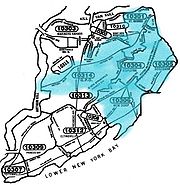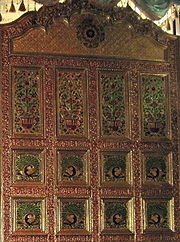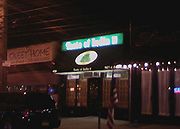From The Peopling of New York City
Contents |
Overview
The Indian community of Staten Island is one that has gone vastly overlooked. The community has its greatest population in the Castleton-Corners and New Springville areas. The Taste of India II, a restaurant located on New Dorp Lane, is an excellent representation of the rich culture that that the Indian people have brought to our humble island.
Demographics
The first thing that became apparent after meticulous searching is that there were no statistical values for American-born citizens who identify culturally as Indian; in fact, the Census Bureau neglected to list any ancestries reported from the Continent of Asia. Thus, the numbers derived here were purely based on the foreign-born populace. This being said, Staten Island is home to 5.1% of New York City's Foreign-born Indian Population. This number does not account for all of the Indian people on Staten Island; this is a number that can only be estimated due to the lack of census information.
A discrepancy that should be noted is that the values were listed differently from census to census; thus, each set of data was listed under a different category. In 1980 and 1990, the Indian population could be found under “Asian-Indians” in the population by race category. It is not clear if these numbers correspond to the number of foreign-born or the total number of Staten Islanders who identify themselves as Indian, thus there may be a discordance in the numbers provided here. According to the available statistics, there was a large increase in population from 1980-1990, while there was a slight decline from 1990-2000.
History
India is a country with a rich culture full of many diverse layers of beliefs and traditions united by an extremely interesting and intricate history. Located on the continent of Asia, it is the largest democracy in the word and the second most-populated country in the world after China. After a long and often repressive occupation by Great Britain, India gained its independence in 1947. However, since long before it was a sovereign nation, India has played an influential role in American society.
The first Indian immigrants came to North America in the 1600s as indentured servants to work in the British colonies. After the United States won its independence from Great Britain, some Indians came to enjoy the benefits of new nation free from British oppression. Unfortunately, Americans did not treat Indian immigrants with respect either as they were barred from citizenship for a period of time.
Today, India has a rapidly growing economy and is quickly becoming a force to be reckoned with on the world stage. Due this newly found economic prowess, Indian immigration to the United States has slowed slightly in recent years. Despite this fact, Indian Americans are making large contributions to American society. They are the most educated foreign-born group in the United States, greatly influencing the medical field and producing such renowned public figures as Bobby Jindal, the Governor of Louisiana, and M. Night Shyamalan, the prominent film director.
The People
The Indian population on Staten Island is rich in culture and diversity. The members of this community come from various backgrounds, all with the common bond of their Indian heritage. Father Albin Roby is just one such example of a proud member of this community. Originally from Southern India, he relocated to the United States to preach his Christian faith. He is now a priest at St. Charles R.C. Church in Oakwood. Kanika Khanna, a college student currently studying at the Macaulay Honors College at CSI, has roots in Amritsar, India. She lives in a household where Indian heritage meets American customs daily, resulting in a vastly multicultural lifestyle.
Ethnic Stages
"Ethnic Stages" refers to the locations on Staten Island or within the community on which people display their community membership and identity. This can mean churches, community centers, specialized stores with products from the home country, restaurants that serve the community's cuisine, or other sorts of institutions.
The Taste of India II is an excellent example of the assimilation of Indian culture into American society. By providing traditional Indian decor and music, the owners cater to Indian customers. However, recognizing American patrons as well, the restaurant provides items on the menu that wouldn't otherwise be found on an Indian menu, such as several beef dishes. It is a pure reflection of how the owners of this establishment have embraced life in America without sacrificing their cultural roots.
Readings
Planet India by Mira Kandar
Traditional India: Structure and Change by Milton B. Singer
Social Work and Social Change: A Case Study in Indian Village Development by Sugata Dasgupta
India: From Midnight to the Millennium by Shashi Tharoor
India after Gandhi: The History of the World’s Largest Democracy by Ramachandra Guha
Passage from India: Asian Indian Immigrants in North America by Joan M. Jensen
The Speaking Tree: A Study of Indian Culture and Society by Richard Lannoy
The Bloodless Revolution: A Cultural History of Vegetarianism from 1600 to Modern Times by Tristram Stuart
Freud Along the Ganges: Psychoanalytic Reflections on the People and Culture of India by Salman Akhtar
In Spite of the Gods, The Strange Rise of Modern India by Edward Luce
Passage from India: Asian Indian Immigrants in North America by Joan M. Jensen
From India to America: A Brief History of Immigration, Problems of Discrimination, Admission and Assimilation by S. Chandrasekhar
From the Ganges to the Hudson: Indian Immigrants in New York City University of New York by Johanna Lessinger
Indian Americans by Padma Rangaswamy
Oral History Project: The Immigrant Experience of Asian Indians in New Jersey by K. Khanna, P. Aiylam Sankaron, Neelam Khanna, Kamlesh Mehrotra, and Ragini Goel
The Social Adaptation of Asian Indian Professionals and their Children in New York City by Jiwan Lata Dixit
Ethnic Identities: Asian Indians in the New York City Area by Maxine P. Fisher
Desis in the House: Indian American Youth Culture in New York City by Sunaina Maira
Chaste Identities; Ethnic Yearnings: Second Generation Indian Americans in New York City by Sunaina Maira
Becoming American, Being Indian: An Immigrant Community in New York City by Madhulika S. Khandelwal




